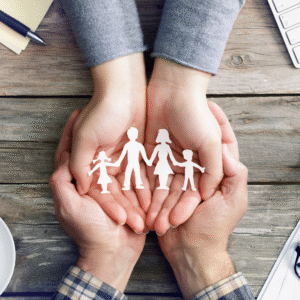Mental health challenges can affect any family, and family members may feel unsure about how to help their loved ones if these issues arise. That’s why it’s important to have a supportive strategy in place. This post will guide you through crafting a Family Mental Health Action Plan using the 6-part Wellness Recovery Action Plan (WRAP) framework. Developing this plan will help you create a nurturing environment that promotes Stigma-Free conversations about mental health and empowers every family member to thrive together.
1. Daily Maintenance Plan
Your daily maintenance plan describes what it looks like when your family is doing well and there are no mental health concerns present. It also lists the self-care activities that keep you all on track to maintain positive mental wellbeing. To create a daily plan, you can have each family member share what activities help them feel supported and calm. It may be helpful to create a calendar of daily rituals, such as evening walks or morning routines. You may also consider scheduling family check-ins after school or work to share your daily highs and lows with one another.
Recommended Resource: Open communication is an important part of creating a mental health plan as a family. Use the Conversation Cards from our Resources for Parents, Guardians and Caregivers to normalize discussions about mental health and learn together!
2. Stressors (Triggers)
 Stressors are events that may affect you emotionally, such as a change in routine, family conflict, or overwhelming work and school commitments or deadlines. Everyone has different stressors – in this step, you have an opportunity to identify stress points for your family so that you can manage them proactively. To recognize stressors and create a plan for addressing them, try collaboratively listing them in a family “brainstorming” activity. Discuss each of your stressors, as well as practical wellness tools you can use to cope with the situation.
Stressors are events that may affect you emotionally, such as a change in routine, family conflict, or overwhelming work and school commitments or deadlines. Everyone has different stressors – in this step, you have an opportunity to identify stress points for your family so that you can manage them proactively. To recognize stressors and create a plan for addressing them, try collaboratively listing them in a family “brainstorming” activity. Discuss each of your stressors, as well as practical wellness tools you can use to cope with the situation.
Looking for coping tools? Our Youth Activities provide resources on mindfulness, emotional awareness, and stress management that are accessible for the whole family. Our Situation Shifter Activity and compilation of mental health videos are go-to resources for caregivers to teach youth how to reframe negative thoughts.
3. Early Warning Signs 
Early warning signs are minor changes that signal a family member may need extra support before their challenges escalate. If not addressed, these warning signs might turn into a larger issue. Taking note of behaviours that hint at underlying concerns – such as withdrawing from friends, changes in sleep patterns, or increased irritability – can allow you to take action early.
Our resources on Coping with Mental Health contain vital information and activities to help you check in with family members, as well as tips on caring for mental health.
4. When Things Are Breaking Down
This part addresses signs that mental health challenges are intensifying and there is a risk of crisis. Consider the next steps you can take to help the person who needs support, including agreed-upon activities you can do together as a family. A component of your plan may also include reaching out to mental health professionals or organizations that can help. To find support resources in your area, visit our Help & Community Resources page.
5. Crisis Plan
 A Crisis Plan ensures you have the tools to deal with mental health emergencies if they occur by laying out support preferences, emergency contacts, and professional resources. As a family, you can discuss: “What does ‘crisis’ mean for each of us?” and “What are the most helpful things we can do to provide support when one of us is experiencing a crisis?” You can also compile a list of national and provincial crisis services. The purpose of this step is to discuss effective ways to address a crisis and have a plan in place so that the situation can be managed appropriately.
A Crisis Plan ensures you have the tools to deal with mental health emergencies if they occur by laying out support preferences, emergency contacts, and professional resources. As a family, you can discuss: “What does ‘crisis’ mean for each of us?” and “What are the most helpful things we can do to provide support when one of us is experiencing a crisis?” You can also compile a list of national and provincial crisis services. The purpose of this step is to discuss effective ways to address a crisis and have a plan in place so that the situation can be managed appropriately.
6. Post Crisis Plan 
The Post Crisis Plan outlines steps to transition back to your daily routine and integrate lessons learned. After a crisis, meet as a family to discuss which coping strategies worked and what could be changed or implemented into your plan in the future.
Resources for Parents and Caregivers: When a family member experiences a mental health crisis, it can place significant stress on parents and caregivers. Part of your post-crisis plan may be taking time to build your resilience and focus on your own wellness to prevent burnout.
Creating a Family Mental Health Action Plan doesn’t have to feel like a chore or task to check off your to-do list – it can be an enriching part of your family’s wellness journey. By using the WRAP framework, you are creating a supportive family dynamic where both caregivers and youth can flourish. We hope this guide inspires you to create a plan to meet your family’s unique needs, and we encourage you to explore the no-cost resources developed by Stigma-Free Mental Health Society to support your family’s mental health.
References
Advocates for Human Potential, Inc. (n.d.). What is WRAP? – Wellness Recovery Action Plan.
Author: Monique Zizzo







